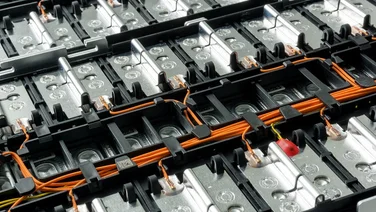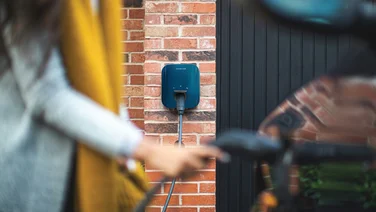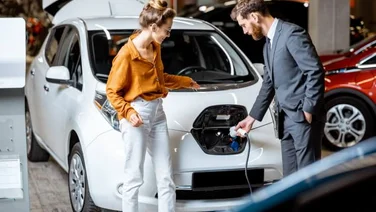- Soon, electric vehicles will come with the ability to use them as portable storage batteries for your home.
- The average EV battery has enough capacity to power a UK home for 4.5 days
- The UK government has committed just £14m to developing the technology
Octopus Energy’s 2024 initiative to use BYD electrical vehicles (EV) as storage batteries for your home sparked an interest on whether you can use it to power your home.
The innovation uses a special technology called bidirectional charging, which could be a game-changer for EV and home battery storage industries.
Given that EV sales in the UK are at an all-time high, with used car sales soaring more than 50% in the first quarter of 2025, could this be another reason to get your hands on one?
But what is this new technology, and how could you jump on the EV-as-a-home battery train? Let’s find out.
Get free EV charging point quotes
Answer a few quick questions, and our trusted installers will send you bespoke EV charging point quotes – for free.
Can I use an EV to power my home?
Yes, you can use bidirectional charging, vehicle-to-grid (VTG), or vehicle-to-house (VTH) technology. With this technology installed, EVs can, in effect, act like home storage batteries when not used for driving.
This technology also enables electric vehicles to supply power to the grid during peak demand, thus supporting the UK’s shift to renewable energy. Vehicles must be specifically designed for it, with appropriate batteries and chargers to direct stored energy to homes or the grid.
Sadly, retrofitting existing EVs with VTG/VTH technology isn’t possible just yet. That being said, the technology’s potential is huge.
The average UK home uses 2,900 kWh of electricity annually, or about 8 kWh per day. A Tesla Model S, with a 95 kWh battery, could power a home for 11 days, while a Nissan Leaf, with a 39 kWh battery, could last nearly five days.
According to the most commonly cited estimate, there are currently around 1.8 million EVs on UK roads. Each of these EVs averages around 40 kWh of battery storage. This means they could collectively store 72 million kWh.
If used solely as a form of power storage, this could power 24,800 homes annually or meet the daily needs of 9 million households. Yet, despite this potential, according to the 2023 National Home Energy Survey, only 55% of Brits would want an EV even if it were free.

What is bi-directional charging?
Bi-directional charging allows EVs to draw power from and supply power to the electric grid or a home. This means you can charge your car like normal, but the energy flow can also be reversed (VTG), enabling the stored energy in the EV’s battery to be fed back into the grid or used to power a home (VTH).
For this reason, this technology has the potential to play a crucial role in balancing the supply and demand of energy.
In other words, EVs could be used to top up power on the grid when demand is high due to drops in supply from sources like wind or solar. They can also charge during low-demand or high renewable energy output periods.
However, there are some things to consider. Since bi-directional charging requires specialised hardware and software. For example, the EVs battery and charger must be designed for two-way energy flow.
This means that only some current EVs are compatible, and most require extra kit or significant modifications (not a cheap undertaking at present). You’ll also need permission from energy suppliers to export energy to the grid.
Bi-directional charging vs one-directional charging
As the terms suggest, bi-directional and one-directional charging serve different functions when using EVs as home batteries.
Depending on which device has the converter, this conversion can happen either within the charger or inside the vehicle. One-directional charging solely focuses on charging the vehicle’s battery from the grid.
Bi-directional charging, on the other hand, allows for energy flow in both directions. With a bi-directional charger, the converter can transform the car’s DC energy back into AC electricity and distribute it to another recipient, such as a home or the grid.
As you can imagine, this reverse process requires smart-charging technology to manage how and when the car takes or returns energy, optimising efficiency and ensuring grid stability.

Credit: ltyuan Adobe
What are the benefits of bi-directional charging?
- Save money on energy use: Households on time-of-use tariffs can charge their EVs at night when electricity prices are lower and use the stored energy during peak hours to reduce energy costs.
- Store backup power for your home or business: VTH technology enables electric vehicles to provide power during outages, sustaining a home or business for days and ensuring continuity without relying on the grid.
- Create a portable power source: EVs equipped with bi-directional charging can function as mobile power units, providing flexibility and convenience for powering various devices and locations.
Powering homes with EVs could revolutionise grid management, reducing strain during peak demand and aiding the UK’s transition to renewable energy. This robust energy storage network will help prevent reliance on polluting power stations when renewable sources are low.
Types of bi-directional charging
- Vehicle-to-Grid (V2G): V2G is, by far, the most common application of bidirectional charging. It enables vehicles to send energy back to the grid through a converter in the charger. V2G enhances local grid efficiency and provides cost savings by compensating charger owners for contributing to grid stability.
- Vehicle to Home (V2H): Bidirectional V2H charging enables your car battery to serve as a backup power source for your home, promoting efficient energy usage and potential cost savings by leveraging technology usually integrated into the charger.
- Vehicle to Load (V2L): V2L charging is widely available now and allows an EV battery to power appliances and tools while on the go. It relies on vehicles with built-in converters and 120-volt plugs, which are increasingly common in modern EVs.
- Vehicle-to-Vehicle (V2V) charging: Technically similar to V2L charging, V2V allows energy transfer from one car to another, effectively addressing range anxiety by ensuring EVs can share power when needed.
Which EVs can I use as battery storage?
As we reported back in July 2024, Octopus Energy and Chinese EV maker BYD have recently teamed up to use the latter’s EVs as bidirectional V2H batteries. The exact model has not yet been disclosed, but likely candidates include BYD’s ATTO 3.
However, it is important to note that this deal relies heavily on Octopus Energy’s proprietary “Kraken” energy management software. While this is a trial, other EV models could be used for the same purpose. These include, but are not limited to:
| Car models | V2G | V2H | V2L |
| Audi Q4 e-tron | ✔ | ✔ | ✔ |
| BYD – all models | ✔ | ||
| Cupra Tavascan (coming 2024) | ✔ | ✔ | ✔ |
| Genesis – all models | ✔ | ||
| Hyundai Ioniq 5 | ✔ | ||
| Kia EV6 | ✔ | ||
| Kia EV9 | ✔ | ✔ | ✔ |
| Kia Niro | ✔ | ||
| MG4 | ✔ | ||
| MG5 | ✔ | ||
| MG ZS | ✔ | ||
| Peugeot e-3008 | ✔ | ||
| Polestar 2 | ✔ | ||
| Polestar 3 (coming summer 2024) | ✔ | ✔ | ✔ |
| Skoda Enyaq | ✔ | ✔ | ✔ |
| VW ID. family | ✔ | ✔ | ✔ |
Modified from Top Gear.
Octopus and BYD’s deal
As we previously mentioned, Octopus Energy and Chinese EV maker BYD have launched a new pilot scheme that allows customers to use their parked electric vehicles as flexible home energy storage batteries. This means Octopus customers can use BYD EV’s bi-directional charging function to power their homes, turning their cars into mobile power sources.
The scheme enables customers to charge their EV batteries at night when costs are lower and utilise the stored power during the day when tariffs are higher. Moreover, customers can sell excess energy back to Octopus, maximising their cost savings.
Initially trialled in Manchester, this initiative highlights BYD’s expansion in the UK and leadership in the EV market. The partnership utilises Octopus Energy’s “Kraken” software to manage the bidirectional charging process efficiently.
Using EVs as home batteries can revolutionise grid management, reducing strain during peak demand, supporting the UK’s transition to renewable energy, and providing financial benefits to users.
This technology, combined with Octopus Energy’s other partnerships, including those of Ford and Tesla, aims to make the energy system more efficient and resilient.
Homeowner case study: Shirley Patterson, homeowner, Fife, Scotland
Over the past couple of years, we have upgraded the original 3 plug-in cars with new fully electric cars (my Skoda Enyaq Coupe with 82kWh battery, my husband’s Skoda Enyaq SUV also with 82kWh battery and my daughter’s new Renault Zoe with a 52kWh battery) – their batteries are fantastic energy storage for our solar energy – their combined storage capacity being 216 kWhs.
The single charge range of the cars are around 340 miles for the Enyaqs and 240 miles for the Zoe. The cars are fuelled at home, the fuel cost being from 0p/mile if entirely via the solar-generated electricity on-site, or up to 2p/mile if fuelled by energy being purchased from energy supplier using the smart-metered time of use tariff which is 7p/kWh including vat.
We have upgraded our first car chargepoint which was installed in 2014, to a smart chargepoint, which can work aligned to our level of solar generation, although generally we give our energy supplier control of when our cars get charged, just by setting how much charge is required and by when, and then leave them to manage the charging when it is greenest and cleanest for the grid, which is typically overnight using cheap energy.
In 2022, I committed to becoming a co-owner of a wind farm, which is now constructed and started generating electricity in June this year. That project is going to support us hugely in attaining a personal net zero.
We presently use 16,500 kWhs of electricity per year, 13,000 kWhs supplied by our energy supplier, and 3,600 kWhs generated by the solar panels – however my small part of the wind farm project is going to be supplying the grid with 19,000 kWhs of electricity per year, so far more than we presently use to fuel our zero emission cars, house, and home-based offices.
Financially, the wind farm generation results in not only helping towards community benefits in the local area of the consumer-owner wind farm’s construction, but also in credits being applied to our energy account, monthly, for the next 25 years, which will further reduce our net energy bill.
Will I need to install a new EV charger?
Yes, you will need a bidirectional EV charger because ordinary EV chargers cannot power your home or feed electricity back to the grid.
Bidirectional chargers function more like inverters than standard EV chargers, meaning they can convert AC to DC while charging and reverse this when discharging your EV’s battery.
Unfortunately, you also need an electric vehicle capable of using a bidirectional charger; right now, there aren’t many available. For example, Ford’s electric F-150 Lightning pickup truck is one model capable of powering a home, but it requires specialist equipment and is only available in the US.
Other than an ongoing trial of 20 Nissan VTG-compatible cars, suitable vehicles are currently out of stock in the UK.
BMW, Peugeot, Volkswagen, and Fiat have all started working on models, and it’s safe to bet that we’ll start seeing them in a few years.
Summary
- The recent Octopus Energy and BYD trial of V2H technology could spark renewed interest in V2H bi-directional charging in the UK market.
- With UK EV sales expected to reach 20% by the end of 2024, this initiative could drive further adoption by showcasing EVs’ dual benefits as transport and energy storage solutions.
- This technology allows EVs to draw power from and supply power to the grid or home, providing energy during high demand and charging during low demand periods.
- Bi-directional charging requires specialised hardware and software, meaning existing EVs need significant modifications to support this technology.
- Using EVs as energy storage can significantly support the grid during peak demand, helping to balance supply and demand, especially as the UK shifts to renewable energy sources.
- Popular EVs, like the Audi Q4 e-tron or Nissan Leaf, have sufficient battery capacity to power homes for several days. Collectively, UK EVs could store enough energy to power thousands of homes annually, though only 55% of Brits express interest in EVs, even if free.







